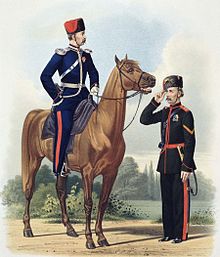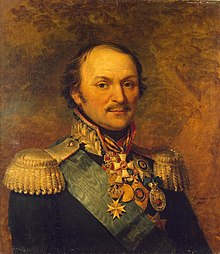Don Cossacks
The Don Cossacks and the Don Cossack Army ( Russian : донское казачье войско) are from the numerically largest sub-group of Cossacks . By 1920 the Don Cossacks comprised approximately one million people. The Cossack Army was established in the 1570s and disbanded in 1918. After 1990, a Cossack renaissance developed in today's Russia, which also affected the Don Cossacks and led to a reactivation of the Don Cossack army.
history
The Don Cossacks formed as fortified farmers against the Tatars from the 15th century . They lived on the Don and its tributaries Medveditsa , Chopjor , Siverskyi Donets and Scherebez. The land was common property with them ( common land ). The Don Cossacks were involved in the Russian colonization of Siberia from the 16th century . The highest military rank among the Don Cossacks is that of an ataman .
War missions and uprisings
In 1641 the Don Cossacks temporarily conquered the Ottoman fortress of Azov on the lower reaches of the Don. In the years 1670 to 1671 the Don Cossacks under Ataman Stenka Razin rose up in a great uprising against the Tsar, who, in their opinion, had curtailed their rights of freedom. The uprising was eventually put down. At the end of the 17th century, the Don Cossacks took part in the Crimean and Azov campaigns on the Russian side . In the 18th century they played an important role in the victorious Russian wars against the Ottoman Empire . Around 1800 they provided 70,000 fighters in the Russian army in the coalition wars against Napoleon . Under General Matwei Platow , they won several important victories against the French and their allies. The resistance of the Don Cossacks to the Bolshevik takeover of power in 1917 ( October Revolution ) led to bitter fighting during the Russian Civil War . After the defeat and the dissolution of the Don Cossack army, the majority of whom were fighting on the side of the White Army , the Bolsheviks began to repress. The policy of decosacization , mass shootings, deportation , emigration and the famine associated with collectivization dealt a severe blow to the Don Cossack population in the early Soviet period.
The Don Cossack Army in the 21st Century
Today, according to some data , the Great Don Army comprises 156,000 Cossacks. As Russian volunteers, they were involved in both the 2008 Caucasus conflict and the war in eastern Ukraine .
Fiction
The novel The Silent Don by Nobel Prize Laureate Mikhail Scholochow is considered an epoch-making work about the Don Cossacks during the Russian Civil War.
See also
literature
- Vladimir L. Genis: Raskazačivanie w Sovetskoj Rossii (The Decosakization in Soviet Russia). In: Voprosy Istorii (Questions of History) , No. 1, 1994.
- Dimitri Volkogonov : Lenin. Utopia and terror . Econ, Düsseldorf, Vienna a. a. 1996, ISBN 3-430-19828-3 .
Web links
- Literature on the Don Cossacks in the catalog of the German National Library
- Cossacks in the Volgograd region
Individual evidence
- ↑ Gunnar Heinsohn : Lexicon of Genocides. Rowohlt Verlag, Reinbek 1998, ISBN 3-499-22338-4 .
- ↑ Don Cossacks' flags (Russia). Retrieved May 20, 2019 .
- ↑ RIA Novosti of August 5, 2008: Russian Cossack ataman denies reports of division in the Cossack army .
- ^ RIA Novosti of August 16, 2006: Cossacks of Abkhazia and Russia sign friendship treaty .
- ^ RIA Novosti of August 2, 2006: Russian Cossacks ready to protect the citizens of Russia in Abkhazia .
- ↑ [1] Die Welt : "Russian Cossacks" defend "Eastern Ukraine"



